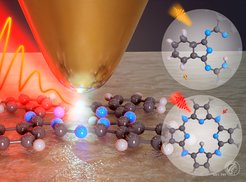Selective excitation of vibrations in a single molecule
The capability to selectively excite atomic vibrations is crucial to driving and controlling chemistry at the single molecule level. A key parameter to driving vibrations in a molecule is the wavelength of the exciting laser. Until date, rapid re-distribution of excitation energy among various vibration modes made selective excitation very difficult in a complex molecule. By placing a single molecule in an ultralow temperature cavity, the re-distribution of excitation energy in the molecule can be significantly decelerated; enabling researchers from Max Planck Institute for Solid State Research (MPI-FKF Stuttgart) and University of Madrid to selective excite vibrations in single complex molecule.
Selective excitation of vibrations can coherently steer chemical transformations in molecules, metal-to-insulator phase transitions and drive solids through a transient superconducting phase. The possibility to drive reaction pathways in molecules by selective excitations of vibrations — mode selective chemistry — has been actively pursued in the last decades but with limited success. Photochemistry and reactions on surfaces depend on vibrational (structural) dynamics unfolding in the electronic states, further fostering the motivation for achieving mode selectivity. In simple polyatomic molecules, because of the limited number of vibration modes, selective excitation is possible. For example, the desorption of H2 molecules from a silicon surface and reaction of hydrogen atoms with semiheavy water molecules (HDO) in the gas phase have been shown earlier to be controllable by laser excitation of specific vibrational modes. However, in complex molecules due to a large number of vibrational modes, selective laser excitation is hindered by rapid redistribution of energy among many modes. The chemistry becomes thermal rather than selective.

In a low-temperature scanning tunneling microscope (STM) operating in ultrahigh-vacuum conditions, complex single molecules can be conveniently decoupled from their interaction with the other molecules, and selective excitation of vibrations is possible by resonant Raman scattering processes as recently demonstrated by the researchers from Max Planck Institute for Solid State Research (MPI-FKF Stuttgart) and University of Madrid. The strong confinement of light under the nanotip apex of the STM allowed excitation and detection of selective vibration modes at the single molecule level with Ångström-scale spatial resolution.











